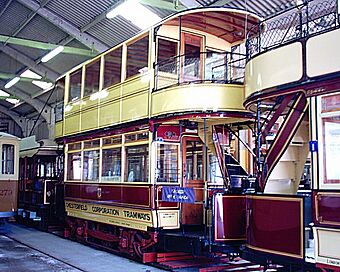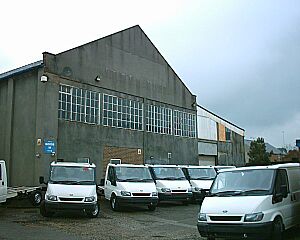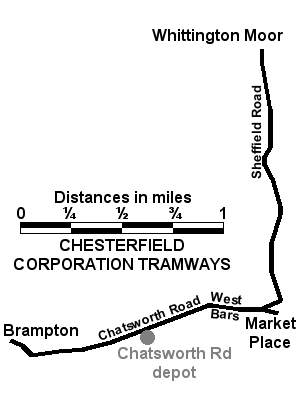Chesterfield tramway facts for kids

Restored electric tramcar no. 7 at the National Tramway Museum, Crich
|
|
| Overview | |
|---|---|
| Headquarters | Chesterfield |
| Locale | England |
| Dates of operation | 1882–1927 |
| Successor | Abandoned |
| Technical | |
| Track gauge | 4 ft 8 1⁄2 in (1,435 mm) |
| Length | 3+5⁄8 miles (5.8 km) |
The Chesterfield Tramway was a public transport system that used trams in Chesterfield, England. It was run by the Chesterfield and District Tramways Company and later by Chesterfield Corporation. The first trams, pulled by horses, started running in 1882.
In 1897, Chesterfield Corporation took over the system. They made it bigger and changed it to use electricity in 1904 and 1905. More electric trams were bought. However, a big fire at the tram depot in 1916 destroyed two trams. During the First World War, it was hard to keep the trams in good repair because there weren't enough staff. Because of these problems, the trams were replaced by trolleybuses in 1927.
Chesterfield Corporation had thought about using trolleybuses much earlier, even getting permission in 1913 to build new trolleybus lines. But they didn't go ahead with it then. When trolleybuses finally arrived in Chesterfield, they mostly used the same routes as the old trams, with a small extra route to New Whittington. The trolleybus system used 19 vehicles, including some double-deckers. The system couldn't grow much because of low railway bridges. This was one reason why the trolleybuses were replaced by regular motor buses in 1938.
Contents
History of the Chesterfield Tramway
The Chesterfield and District Tramways Company got permission to build two tram lines in Chesterfield in 1879. They only built part of one line, which was about 1.25 miles (2.0 km) long. This line ran from Brampton to the town centre at Low Pavement. The company built a depot for the trams at Rodney Yard.
The tram line was built slowly, but it finally opened on 8 November 1882. The trams were pulled by horses. There were three trams: two with two decks and one with a single deck. All were built by Ashbury Railway Carriage and Iron Company Ltd. The company didn't last long and closed down in February 1885.
New Owners and Electric Trams
The Chesterfield Tramways Company took over the tramway in December 1886. They bought two more trams and made the ticket prices cheaper. Chesterfield Corporation wanted to own the tram system, and in 1897, they bought it for £2,050. They took control on 22 November.
Chesterfield Corporation bought new trams in 1898 and 1899. They also bought two used double-deck trams from Sheffield Tramway in 1903. By this time, the Corporation was planning to make the tram lines longer and use electricity instead of horses. They got permission for this work in 1904.
The horse tram service stopped in August 1904 so the old tracks could be replaced. A new section of track was built, going north from the Market Place to Whittington Moor. This more than doubled the length of the system. Horse trams started running again on the Brampton line once it was finished. The electric tram service began in stages. The route to Brampton was running by 23 December 1904. Half of the new route to Stonegravels started on 24 December. The final part to Whittington Moor opened on 31 January 1905. The first electric trams were twelve open-topped double-deckers built by Brush Electrical Engineering Company.
A new depot was built on Chatsworth Road to house the electric trams. It had four tracks over inspection pits, which are special areas for checking the trams from underneath. The tram shed was 126 feet (38 m) long and 26 feet (7.9 m) wide. It was made of bricks with a slate roof and is one of the few original tramway buildings still standing.
Most of the tramway had a single track with places where trams could pass each other. There was double track in the town centre. Weekends were very busy, so the line was run in two parts, as trams were not allowed through the town centre.
The corporation bought two more trams in 1907 and a water car in 1909. By this time, the tram system was having problems. The tracks were wearing out, especially on curves. The system was paid for with long-term loans, but not many more people were using the trams, so money problems started to grow. The overhead wires and the trams themselves also needed repairs. Despite this, three new balcony trams were bought from Brush in 1914.
An extension was added to the depot in 1914 to fit the extra trams. During the First World War, fewer staff worked on the tramway, and the tracks suffered from not being maintained. Women were hired to work as conductors and drivers. After the war, young men returned to their jobs, but some women continued to work until the end of 1921.
In the mid-1920s, the Corporation decided to replace the trams with trolleybuses. The overhead wires needed to be changed for the new trolleybuses. To allow this work, the tram service to Brampton stopped on 28 February 1927. Petrol buses were used instead until the new wiring was ready. Trams on the Whittington Moor section stopped running from 23 May 1927, also replaced by petrol buses during the conversion.
Trolleybuses in Chesterfield
| Chesterfield Corporation Railless Traction Act 1913 | |
|---|---|
| Act of Parliament | |

|
|
| Citation | 3 & 4 Geo. 5. c. xxxv |
Chesterfield Corporation almost became one of the first places to use trolleybuses. In 1913, they got permission to build five trolleybus routes. These routes would have extended the tramway system. However, they didn't go ahead with the plan at that time.
It wasn't until the 1920s, when the tram tracks needed major repairs, that they thought about trolleybuses again. In 1926, they ordered 14 trolleybuses from Straker-Squire. The first trolleybus arrived in Chesterfield on 21 April 1927 for testing. The overhead wiring for the Brampton section was finished on 23 May 1927, and trolleybuses started running that evening. The northern route to Whittington Moor was then converted, and the full service began on 27 September 1927. The trolleybus route mostly followed the old tram route.
A new depot was built at Thornfield, Stonegravels. It was 295 feet (90 m) by 150 feet (46 m) and could hold 100 vehicles. It was used by both trolleybuses and motor buses.
Within a month of the new service starting, the corporation decided to extend the northern route from Whittington Moor to New Whittington. This extension was just over 2 miles (3.2 km) long. Trolleybuses began running to New Whittington on 29 July 1929. Two low double-deck trolleybuses were bought in 1931. The last trolleybuses were bought in 1936. These were three used single-deck trolleybuses from York.
The decision to replace the trolleybuses with motor buses was made in 1937. Reasons for this included the need to replace the overhead wiring, the cost of electricity, and that low railway bridges stopped the system from expanding. The trolleybus system closed on 24 March 1938. The unwanted trolleybuses were sold to a scrapyard for £80.50.
Tram and Trolleybus Vehicles
The Chesterfield tramway used different types of vehicles over the years.
Horse Trams
| Car numbers | Type | Year built | Builder | Seats | Notes |
|---|---|---|---|---|---|
| 1-2 | Open top | 1882 | Ashbury | 32 | |
| 3 | Single deck | 1882 | Ashbury | 16 | |
| 4-5 | Single deck | 1890 | Milnes | 16 | |
| 6 | Single deck | 1898 | Milnes | 16 | |
| 7-8 | Single deck | 1899 | Milnes | 16 | No.8 is preserved |
| 9 | Open top | 1903 | 32 | From Sheffield |
Horse trams 1 and 2 had special trucks that made them lighter. The seats on the lower deck faced forward. On the upper deck, there was a central seat where passengers faced the sides.
Horse tram No. 8 was sold when the system became electric. It was used as a summer house until 1934. Later, it was restored by the Corporation Transport Department. It was then given to the Science Museum. Since 1985, it has been on loan to the National Tramway Museum at Crich. In 2016, the museum became its owner. It has been on display there since 1993.
Electric Trams
| Car numbers | Type | Year built | Builder | Seats | Length | Wheelbase |
|---|---|---|---|---|---|---|
| 1-12 | Open top | 1904 | Brush | 22+34 | 26 ft (7.9 m) | 8 ft 6 in (2.59 m) |
| 13-14 | Open top | 1907 | Brush | 22+34 | 8 ft 6 in (2.59 m) | |
| 15 | Water car | 1909 | Brush | none | 8 ft 6 in (2.59 m) | |
| 16-18 | Balcony | 1914 | Brush | 22+34 | 8 ft (2.4 m) |
The first 12 electric trams were built by Brush Electrical Engineering Company. They had seats for 22 people inside and 34 on the top deck. Five more trams and a water car were bought by 1914.
A fire at the depot on 20 October 1916 damaged many trams. Tram 8 and one of the 1914 trams were too damaged and were scrapped. The others were repaired. Some of the open-topped trams later had roofs added to their top decks, turning them into "balcony" cars. The water car was a single-deck vehicle with a large 2,000-imperial-gallon (9,100 L) water tank in the middle. It was used to spray water on the roads and tracks.
Tramcar No. 7 was sold when the system closed in 1927. It became a holiday cottage in Derbyshire. In 1973, the Tramway Museum Society bought it and moved it to Crich for restoration. It was restored between 1993 and 1996. Since 1997, it has been running on the line at Crich Tramway Village.
Trolleybuses
| Fleet numbers | Chassis | Body | Type | In service |
|---|---|---|---|---|
| 1-12, 14-15 | Straker-Clough | Reeve & Kenning | single deck | 1927 |
| 16-17 | Ransomes D2 | Ransomes | double deck | 1931 |
| 18-20 | Karrier E4 | Roe | single deck | 1936 |
Trolleybuses 18 to 20 were originally built for the York trolleybus system in 1931.
The Chesterfield system also tested several visiting trolleybuses. One was an English Electric single-deck vehicle in June 1928. Another was a prototype Leyland double-deck trolleybus, which was tested from August to October 1931. It looked like a motorbus. This vehicle later worked in Birmingham and was eventually preserved. Another Leyland single-deck trolleybus was tested from September to December 1933. In December 1935, a large three-axle Leyland double-deck demonstrator was tested.
Images for kids
| Tramways in Derbyshire (Closed systems) |
||
|---|---|---|
|
Ashby & Burton • Chesterfield • Derby • Glossop • Ilkeston • Matlock • Nottinghamshire & Derbyshire |
||
| Transport in Derbyshire | edit | |




